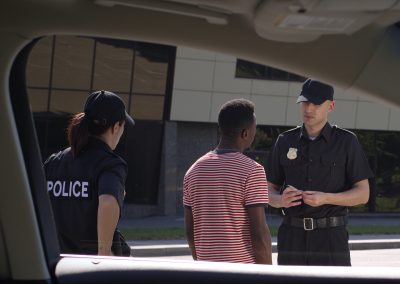Every year there are tens of thousands of collisions involving police officers. Many of the collisions result in an injury or death. Current police collision data only tracks fatalities, injuries and seatbelt usage. However, there’s no record of how the officer was killed or injured in the collision.
The frightening reality is that, more often than we realize, what causes the most bodily damage is the necessary equipment and accessories in the cockpit of the car. Sometimes it’s due to driver distraction while using the equipment. Other times the equipment itself suddenly becomes a lethal projectile during a crash.
Avoidable accidents have a tragic effect on the lives of officers and their families as well as a dramatic impact on the agency involved. Lost time from injured personnel and the high cost of a medically retired officer are just two examples. Agencies incur costs averaging $29,000 for each officer injured in a collision.
When you consider all the elements involved, such as firearms, gun racks, radar, LPR (license plate recognition) equipment, video and computer devices—all combined with powerful vehicle airbags—it’s easy to see how dangerous the cockpit of a police vehicle can be in the event of a collision. But when the right precautions are taken, a cleaner, safer cockpit environment is achievable without reducing productivity or compromising ergonomics.
Key Questions
Following are some of the essential questions agencies must ask when assessing vehicle equipment and installation.
1. How and where are your gun racks mounted?
2. Are the radar/lidar/video/LPR units mounted, freestanding or built-in to a system?
3. What is the location of the in-car computer?
4. Where are the airbags in relation to all the equipment?
5. Is the mic within easy reach, but out of the way?
6. Can these devices be safely activated or used while driving?
7. Can they be operated while wearing gloves?
The choice of equipment and how it’s oriented in the vehicle is extremely important. Other factors to consider include: Uniformity/fleet standards, communications and airbag compliance.
Set-Up Recommendations
Firearms & Gun Racks
The preferred mounting/placement method, which is also airbag compliant, is for firearms to be secured between the front seats and locked in a rack with the muzzles pointed up. This positioning allows firearms to be accessible from both the driver and passenger seats while not hindering the occupant’s ability to exit the vehicle quickly. This positioning also adds crush protection in case of a rollover.
The alternative is to keep long guns in a rack located in the trunk, which complies with officer training and tactics. Mounting firearms overhead, behind the head mounts, on the passenger side console or floorboards are dangerous methods that can cause serious injury in any collision.
Communications Equipment
Radar/lidar, LPR and video equipment should be mounted low to the dash, out of the line of sight and free from blocking any mirrors. They should be hard-mounted to stay in place during a collision.
Vehicle Computers
Choosing the right computer equipment and correctly orienting the hardware in the cockpit are the most important factors.
There are three basic designs: Modular, tablet and laptop. The modular design is highly recommended because it provides for the display to be dash-mounted out of the driver and passenger’s field of view and can be positioned to maintain airbag compliance. With a modular system, the computer display can be mounted without a pole in the passenger area which can be harmful in a collision, and the CPU can be mounted in the glove box or trunk which reduces the amount of potentially hazardous equipment cluttering the cockpit.
Additional safety features offered by select manufacturers include protective crash padding around the display or tablet and tablet docking options that allow for airbag compatibility.
A Company that Puts Safety First
Data911 has been serving the public safety market for 32 years. Its suite of mobile solutions is designed to keep field personnel informed, efficient and safe. Data911’s rugged displays are ergonomically optimized and can be dash-mounted, safely out of the airbag zone. Unlike laptops, there’s no worry about equipment dislodging and causing injury to the driver or passengers in the event of airbag deployment.
Data911 recently introduced its next generation M7+ Display, the first multi-touch display specifically designed for emergency vehicles. This fixed-mount display is dual airbag compatible and has crash padding covering the entire display top. For additional safety, the display has anti-distraction features such as “Blank on Motion” and one-button “Stealth Blackout Mode.” The M7+ Display supports five simultaneous touches and even works with gloved fingers.
Among several product innovations Data911 recently introduced is the new ruggedized tablet PC with an ultra-slim, secure docking station that allows for optimized ergonomics and airbag compatibility. The TX1 Tablet has a sunlight readable multi-touch touchscreen and comes standard with crash padding on the corners.
Additionally, Data911 has launched high-definition LPR. Data911’s LPR technology is integrated with their video software, providing fleet-wide LPR without requiring a separate dedicated computer per vehicle to run the application.
Exterior Vehicle Safety
There are several key factors to consider regarding exterior vehicle safety: sirens, lighting and markings/insignia. The siren should be mounted on the front of the vehicle facing out. It should cover the full auditory spectrum of high and low frequency, and should automatically disable when the door opens.
Lighting should be chosen based on how well it operates in very bright or dim light as well as in severe weather conditions. Vehicle markings should be easily identifiable, reflective, contrast with the car paint color and be visible from all angles.
Department-Wide Input
Deciding on what equipment is purchased and how it’s oriented in the vehicles involves many stakeholders. Ideally, input is gathered from fleet administrators, IT personnel and sworn personnel from the department’s training, patrol and criminal investigations units—all with the underlying goal of maximizing officer safety while providing the equipment they need to succeed in their job of protecting the public.










0 Comments